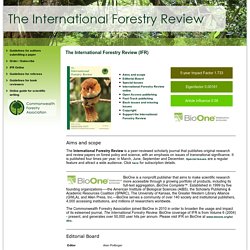

Private Forest Landowners are Making a Difference. A continuous series of activities to ensure that working forests balances the economics we need with the social and environmental values we desire.

Developing a Forest Management Plan Long-term Planning (10+ years) Long-term strategic planning begins with the development of a forest management plan. This takes into consideration the landowners’ objectives, current inventory of timber and growing stock. Constraints are identified for areas that are unavailable for timber harvest. This is all within the context of sustainable harvest levels designed to produce a continuous level of timber harvest in perpetuity. Identifying Stands for Potential Harvest Mid-term Planning (5+ years) Planning for potential harvest of a stand starts five years or more in advance of a scheduled harvest.
Identification of stands for potential harvest can occur five or more years in advance. Planning Individual Harvest Units Annual Planning Selecting Individual Harvest Units On Site Activities. Amazon. 6 Reasons Stopping Deforestation (Still) Matters - Greenpeace USA. Over the past few years, we’ve gained significant ground in getting major companies to move toward forest-friendly business models.

You might think that means deforestation is beginning to be a thing of the past. We want it to be. Unfortunately, threats to forests are only increasing. Just last year, the rate of deforestation in the Brazilian Amazon rose for the first time since 2008. A barge loaded with timber in Para state. Deforestation is not just an environmental issue. 1. Although they still cover about 30 percent of the Earth’s land area, we lose an area roughly equivalent to the size of Panama in forested land every year. A boy and two old women of a community of Baka people (pygmies) who live on the outskirts of Libongo, Cameroon. 2. An additional 1.4 billion people depend directly on forest goods for their survival.
Ten Reasons to Reduce Tropical Deforestation. We already know we are putting too much heat-trapping carbon dioxide (CO2) into the air when we burn fossil fuels to generate electricity, fuel our cars, and heat our homes—but by cutting down and burning trees, we are also releasing an astounding amount of the same heat-trapping carbon dioxide into the atmosphere.

Tropical deforestation accounts for about 10 percent of the world's global warming pollution. Here are just 10 reasons why investing in forest protection initiatives is in the nation's best interest: 1. Global warming is global.Every molecule of CO2 traps heat in Earth’s atmosphere, regardless of whether the CO2 comes from the tailpipe of a car, the smokestack of a coal-fired power plant, or the burning of a tropical tree. Thus, to address global warming, we need to reduce the CO2 produced everywhere on Earth, not just in the United States. Solutions to Deforestation - Greenpeace USA. The causes of deforestation and degradation vary from region to region.

In the tropics, agribusiness clears forests to make space for things like cattle ranching, palm oil and soy plantations for animal feed. Demand for wood products can threaten forests around the world, whether it is for throw-away paper products or hardwood flooring. In too many parts of the world, ineffective or corrupt governments make things worse by opening the door to illegal logging and other crimes. CFA - International Forestry Review. BioOne is a nonprofit publisher that aims to make scientific research more accessible through a growing portfolio of products, including its full-text aggregation, BioOne Complete™.

Established in 1999 by five founding organizations–—the American Institute of Biological Sciences (AIBS), the Scholarly Publishing & Academic Resources Coalition (SPARC), The University of Kansas, the Greater Western Library Alliance (GWLA), and Allen Press, Inc. —BioOne serves a community of over 140 society and institutional publishers, 4,000 accessing institutions, and millions of researchers worldwide. The Commonwealth Forestry Association joined BioOne in 2010 in order to broaden the usage and impact of its esteemed journal, The International Forestry Review. BioOne coverage of IFR is from Volume 6 (2004) - present, and generates over 50,000 user hits per annum. Please visit IFR on BioOne at www.bioone.org/loi/ifre.